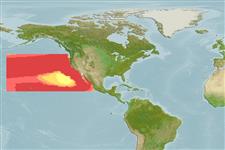>
Anguilliformes (Eels and morays) >
Nemichthyidae (Snipe eels)
Etymology: Nemichthys: Greek, nema, -atos = filament + Greek, ichthys = fish (Ref. 45335); larseni: Named for Verner Larsen, who began the study of this species while at the University of Copenhagen.
Eponymy: Verner Larsen is a Danish ichthyologist, who began revising Nemichthys whilst still a student at the University of Copenhagen, and who, according to the etymology, “…generously handed over his material” to the authors “…when he was unable to finish [...] (Ref. 128868), visit book page.
More on authors: Nielsen & Smith.
Environment: milieu / climate zone / depth range / distribution range
Ecologia
marino batipelagico; distribuzione batimetrica 170 - 1280 m (Ref. 96339). Deep-water; 47°N - 17°N, 170°E - 105°W
Eastern Pacific: Oregon, USA to central Mexico, including the Gulf of California; also Hawaii and north of Hawaii to about 38°N.
Size / Peso / Age
Maturity: Lm ? range ? - ? cm
Max length : 161 cm TL maschio/sesso non determinato; (Ref. 40789)
Short description
Chiavi di identificazione | Morfologia | Morfometria
Raggi dorsali molli (totale) : 173 - 222; Raggi anali molli: 164 - 208. Most easily distinguished from N. scolopaceus by its pale color; has more postorbital and preopercular pores. Rectangle formed by the lateral line pores is shorter and higher than in scolopaceus. Resembles N. curvirostris in its pale color but the subcutaneous dark bars are not as evident. May be instantly distinguished from curvirostris by the more numerous postorbital and preopercular pores and the much shorter and higher rectangle formed by the lateral line pores. Has smaller teeth than curvirostris.
Mesopelagic (Ref. 58302). Minimum depth from Ref. 58018.
Life cycle and mating behavior
Maturità | Riproduzione | Deposizione | Uova | Fecundity | Larve
Nielsen, J.G. and D.G. Smith, 1978. The eel family Nemichthyidae (Pisces, Anguilliformes). Carlsberg Found., Dana-Rept. No. 88:71 p. (Ref. 7450)
IUCN Red List Status (Ref. 130435: Version 2024-1)
Threat to humans
Harmless
Human uses
Strumenti
Special reports
Download XML
Fonti Internet
Estimates based on models
Preferred temperature (Ref.
123201): 6.8 - 7.9, mean 7.4 °C (based on 6 cells).
Phylogenetic diversity index (Ref.
82804): PD
50 = 0.6270 [Uniqueness, from 0.5 = low to 2.0 = high].
Bayesian length-weight: a=0.00102 (0.00046 - 0.00225), b=3.06 (2.88 - 3.24), in cm total length, based on all LWR estimates for this body shape (Ref.
93245).
Trophic level (Ref.
69278): 3.5 ±0.5 se; based on size and trophs of closest relatives
Resilienza (Ref.
120179): Basso, tempo minimo di raddoppiamento della popolazione 4.5 - 14 anni (Assuming tmax>10).
Fishing Vulnerability (Ref.
59153): Very high vulnerability (90 of 100).
